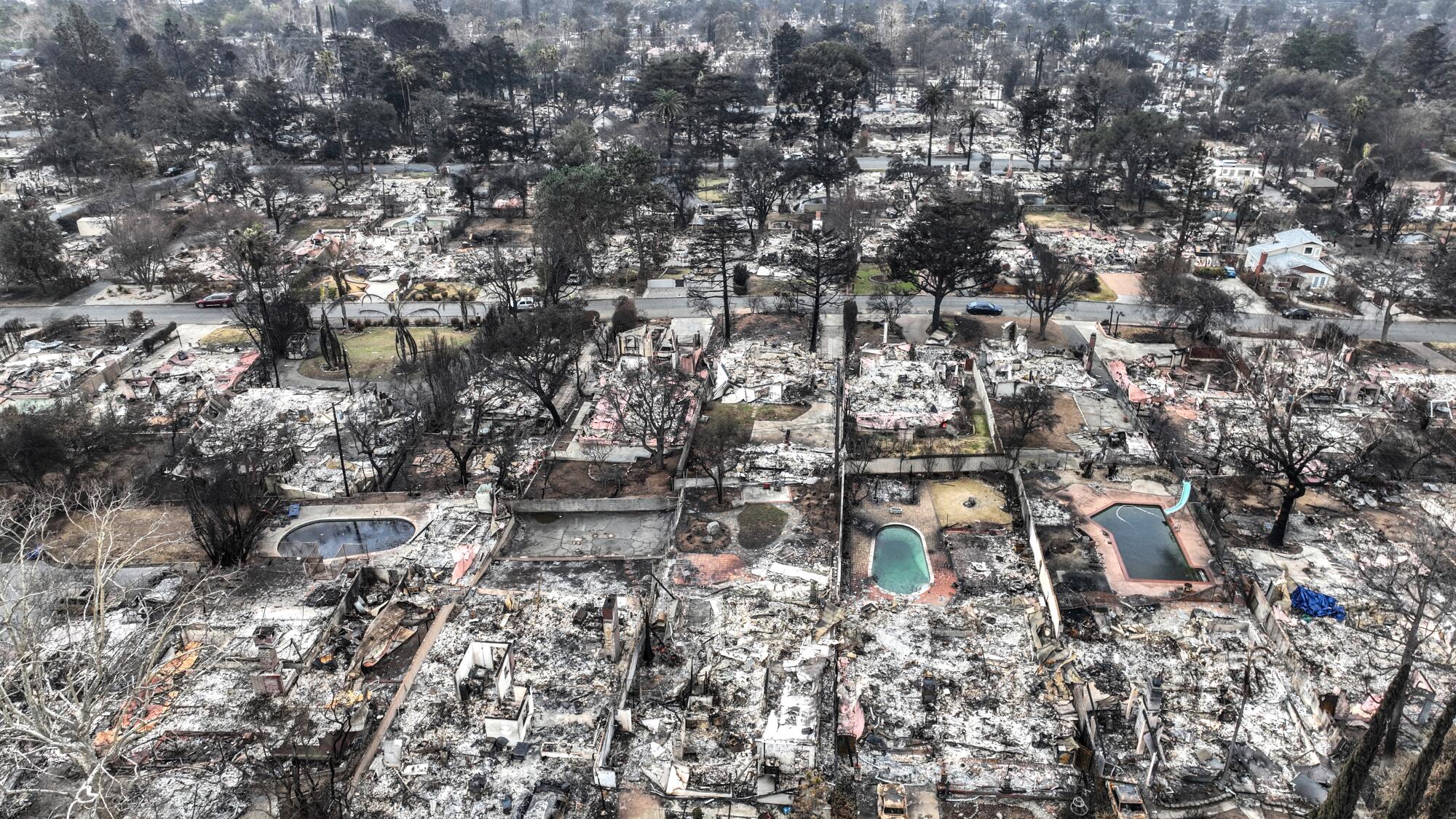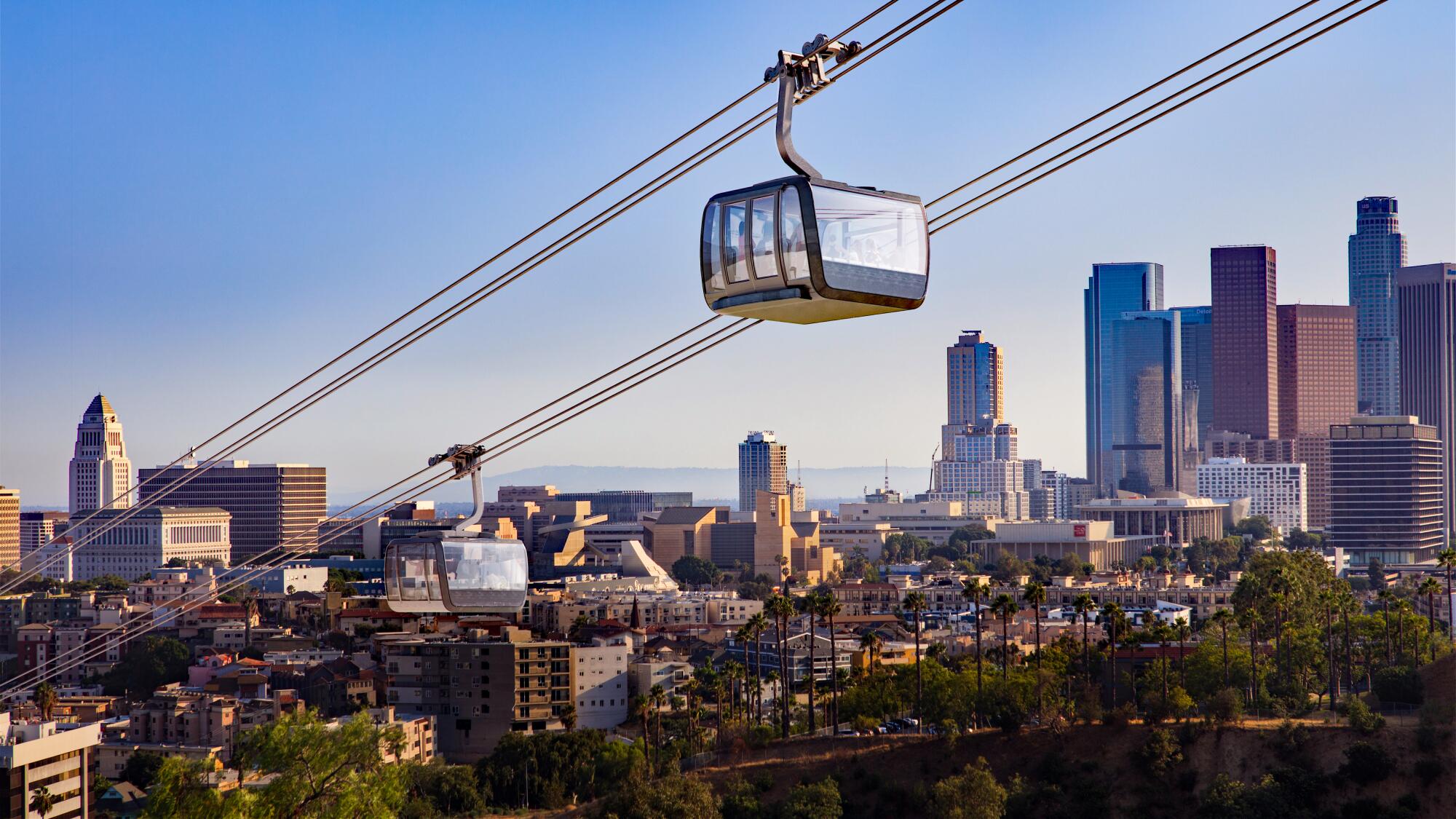‘It’s effectively a bailout’: Edison benefits from fine print in Newsom’s last-minute utility legislation
Standing behind a lectern emblazoned with the words “Cutting Utility Bills,” Gov. Gavin Newsom signed into law last month a package of energy bills that he said “reduces the burden on ratepayers.”
Tucked into one of those bills: a paragraph that could allow Southern California Edison to shift billions of dollars of Eaton fire damage costs to its customers.
Among other things, the bill allows Edison to start charging customers for any Eaton fire costs exceeding the state’s $21-billion wildfire fund.
“I was shocked to see that,” said April Maurath Sommer, executive director of the Wild Tree Foundation, which tracks state government actions on utility-sparked fires. “It’s effectively a bailout.”
Other amendments in the 231-page bill known as SB 254 helped not just Edison, but all three of the state’s biggest for-profit utilities, further limiting the costs that they and their shareholders would face if the companies’ equipment ignited a catastrophic wildfire.
Previous legislation championed by Newsom, a 2019 bill known as AB 1054, already had sharply limited the utilities’ liabilities for wildfires they cause.
Staff in the governor’s office declined a request for an interview. In a statement, Daniel Villasenor, a spokesman for Newsom, called SB 254 “smart public policy, not a giveaway.”
Newsom’s staff noted that the state Public Utilities Commission would later review Eaton fire costs, determining if they were “just and reasonable.” If some costs billed to customers were rejected in that review, Edison shareholders would have to reimburse them for those amounts, the governor’s office said.
According to the legislation, that review of costs isn’t required until all Eaton claims are settled, leaving the possibility that customers would have to cover even costs found to be unreasonable for years.
“That will be expensive news to a lot of people,” said Michael Boccadoro, executive director of the Agricultural Energy Consumers Assn. “It is unfortunately what happens when major policies are done in the final hours of the Legislature with little transparency.”
Damages for the Eaton fire have been estimated to be as high as $45 billion — which could greatly exceed the $21-billion fund.
Homes in Altadena lay in ruins after the Eaton fire.
(Robert Gauthier / Los Angeles Times)
Sheri Scott, an actuary at Milliman, told state officials in July that insured losses alone range from $13.7 billion to $22.8 billion. That estimate doesn’t include payments to families who were uninsured or underinsured, or compensation for pain and suffering.
The bill allows Edison to issue bonds secured by new payments from its electric customers for Eaton fire costs that can’t be covered by the $21-billion fund.
Kathleen Dunleavy, an Edison spokeswoman, said the company supported the bill’s language because the bonds secured by customer payments provide a lower cost of borrowing than if the company used traditional financing. “Every dollar counts for our customers,” Dunleavy said.
“There are a lot of variables here,” Dunleavy added. “The investigation is ongoing and there is not an estimate of the total cost of the Eaton fire.”
Newsom’s office noted that under the amendments the utilities won’t get to earn a profit on $6 billion of wildfire prevention expenditures. Customers will still have to pay for the costs, but they won’t be charged extra for shareholders’ profit.
Since early this year, Edison, Pacific Gas & Electric and San Diego Gas & Electric had been lobbying Newsom and state legislative leaders, urging them to bolster the $21-billion fund because of concerns it could be exhausted by the Eaton fire’s extraordinary cost.
Videos captured the Jan. 7 inferno igniting under a century-old transmission line that Edison had not used for 50 years. The wildfire swept through Altadena, destroying 9,400 homes and other structures and killing at least 19 people.
Edison now faces hundreds of lawsuits filed by victims. The suits accuse Edison of negligence, claiming it failed to safely maintain its equipment and left in place the unused transmission line, which lawyers say Edison knew posed a fire risk.
“We’ll respond to the allegations in the litigation,” Dunleavy said, adding that the company inspects and maintains idle lines in the same way as its energized lines.
Even though the government’s investigation into the cause has not been released, Edison announced in July that it was starting a program to directly pay victims for damages.
The company has also begun settling with insurance companies that paid out claims for properties they insured in Altadena that were destroyed or damaged.
Limiting Edison’s liability for Eaton fire
The utility is expecting to be reimbursed for most or all of the settlements and the costs of the fire by the $21-billion wildfire fund that Newsom and lawmakers created through the 2019 legislation, according to a July update Edison gave to its investors.
The first $1 billion of damages is covered by an insurance policy paid by its customers.
After state officials warned that the Eaton fire could deplete the state fund, Newsom said in July he was working on a plan to create an additional fund of $18 billion.
Two days before the Legislature was scheduled to recess for the year, three lawmakers added complex language to SB 254 to create what Newsom called the new $18-billion wildfire “continuation account.” Before the bill was amended, consumer groups had been supporting it because it aimed to save electric customers money.
The late amendments required the Legislature to extend its session by a day to meet a state constitutional rule that says proposed legislation must be public for 72 hours before a final vote.
“It’s impossible to believe that legislators could have understood all of this in 72 hours,” Maurath Sommer said. She noted that Newsom’s 2019 law, AB 1054, was introduced and quickly passed in a similar manner. “And it is clear now how poorly that effort fared in achieving the claimed objective of protecting public safety.”
Boccadoro said he believed the amendments were added to a bill favored by consumer groups to give it “some political cover.”
Assemblymember Cottie Petrie-Norris (D-Irvine), one of bill’s authors, said she believed utilities needed protection from wildfire liabilities because of a legal doctrine in California known as inverse condemnation, which makes them responsible for damages even if they weren’t negligent in starting it.
“This is the best possible deal for ratepayers as we navigate the truly devastating impacts of the climate crisis,” Petrie-Norris said of the legislation. The other two authors — state Sens. Josh Becker (D-Menlo Park) and Aisha Wahab (D-Hayward) — did not respond to requests for interviews.
After the bill passed, both Edison and PG&E praised its provisions in presentations for investors.
Edison called the bill “a key action” that demonstrated lawmakers’ support of its “financial stability.”
The amendments added to the protections that utilities gained in 2019 through Newsom’s AB 1054. At that time, PG&E was in bankruptcy proceedings. It had filed for protection after its transmission line was found to have ignited the 2018 Camp fire, which killed 85 people and destroyed most of the town of Paradise.
PG&E explained in a September presentation that before Newsom and lawmakers changed the law in 2019, utilities that wanted to pass fire damage costs to customers “bore the burden of proving” that their conduct related to the blaze was reasonable and prudent.
Newsom’s 2019 law changed that standard, PG&E said, so that the utility’s conduct was automatically deemed reasonable if state regulators had granted the company what the law called a safety certificate.
Since 2019, the state has regularly issued the companies these certificates — even when regulators find maintenance and safety problems.
Edison received a safety certificate less than a month before the Eaton fire, even though it had thousands of open work orders, including some on the transmission lines in the canyon where the fire started.
To get a certificate, the utilities must submit a plan to state regulators for preventing their equipment from sparking fires. They also must tie executive pay to the company’s safety performance, with bonuses expected to take a hit when more fires are sparked or people are killed.
Even though Edison failed at key safety measures last year, The Times found that cash bonuses for four of its top five executives rose. The company said that was because of their performance on responsibilities beyond safety.
With a safety certificate in hand, Edison told investors in July that the maximum it would pay for the Eaton fire under the law’s limit was $3.9 billion, a fraction of the expected costs. The utility said the wildfire fund would reimburse it for all the costs, unless an outside party can raise “serious doubt” that it had not acted reasonably before the fire.
The SB 254 amendments also clarified key language in the 2019 law — clarifications that Edison told investors in September were “constructive for potential Eaton fire losses.”
That language allows utilities that cause repeated major wildfires within a period of three years to reduce what they must pay back to the fund for a second fire if they are found to have acted imprudently.
“This certainly does not seem to encourage utilities to stop causing fires,” Maurath Sommer said of the provision.
Edison’s Dunleavy dismissed concern about the provision. “Safety remains our top priority,” she said.
Campaign contributions to Newsom
The three utilities have long been generous political donors to both Democrats and Republicans in California, including to Newsom and current legislative leaders in Sacramento.
Edison, for example, gave $100,000 to Newsom’s campaign last year to pass the mental health initiative known as Proposition 1.
This summer Edison gave $190,000 to the state Democratic Party, which is helping Newsom campaign for Proposition 50, which would redraw congressional districts.
Newsom’s staff didn’t respond to questions about the contributions.
Dunleavy said that the company’s political donations are not charged to customers. She said Edison gives contributions to politicians who share its commitment to “safely serve our customers.”
Newsom said in 2019 that the bill capping utilities’ fire liabilities would “move our state toward a safer, affordable and reliable energy future.”
He and lawmakers said the law would make the public safer by requiring the utilities to do more to prevent fires, including aggressive tree trimming and the installation of more insulated wires.
Even though the utilities have raised electric rates to charge customers for billions of dollars of fire prevention work, their electrical equipment continues to spark blazes.
According to Cal Fire statistics, if the Eaton fire is confirmed to have been ignited by Edison’s transmission line, at least seven of the state’s 20 most destructive wildfires would have been caused by the three utilities’ power lines. Two of those utility-sparked fires happened after the 2019 law passed.
Edison’s lines ignited 178 fires last year — 45% more compared with 2019. The company attributed last year’s increase to weather conditions that created more dry vegetation.
The governor’s staff said they disagreed with claims that the legislation reduced utilities’ accountability. They pointed to a measure in the 2019 law that requires a utility to reimburse the wildfire fund for all damages from a fire if its actions are found to constitute “conscious or willful disregard of the rights and safety of others.”
Advocates for utility customers have repeatedly said they believe that standard is too high to keep California utilities from causing more fires.
“Instances of utility mismanagement could easily fall short of the ‘conscious or willful disregard’ standard yet nonetheless cause a series of catastrophic wildfire events,” wrote the commission’s Public Advocates Office in a filing soon after the 2019 law passed.

